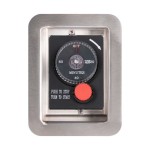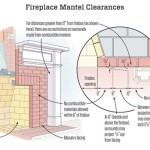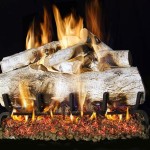How to Build a Corner Fireplace Mantel and Surround
A corner fireplace can serve as a captivating focal point within a room, offering both aesthetic appeal and functional warmth. Enhancing the visual impact of a corner fireplace often involves the construction of a mantel and surround. This project, while requiring moderate woodworking skills, can be approached methodically with careful planning and execution. The following article outlines a comprehensive process for building a corner fireplace mantel and surround, providing a detailed guide for achieving a professional and aesthetically pleasing result.
Before commencing the construction process, it is imperative to thoroughly assess the existing fireplace structure and measure the available space within the corner. Precise measurements are essential for accurately designing the mantel and surround. Consider the overall dimensions of the fireplace opening, the hearth size, and the desired height and width of the mantel. An accurate sketch or CAD drawing will serve as a valuable reference throughout the building process.
Furthermore, understanding local building codes and regulations regarding fireplace surrounds is crucial. These codes may dictate specific material requirements, clearances from combustible materials, and installation guidelines. Consulting with a local building inspector can help ensure compliance and prevent potential safety hazards.
Selecting Materials for Durability and Aesthetics
The choice of materials for the mantel and surround significantly impacts both the visual appeal and longevity of the project. Common material choices include wood, stone, brick, and manufactured stone veneer. Each material offers unique aesthetic characteristics, cost considerations, and installation requirements.
Wood is a popular choice due to its versatility, affordability, and ease of workability. Hardwoods such as oak, maple, and cherry provide durability and a rich, natural appearance. Softwoods like pine and fir are more cost-effective but may require additional finishing and protection. When selecting wood, ensure it is properly dried and free of knots or imperfections that could compromise structural integrity.
Stone and brick offer a more substantial and traditional aesthetic. Natural stone provides a unique, organic texture, while brick offers a classic, timeless appeal. These materials are inherently fire-resistant and can withstand high temperatures. However, stone and brick installation requires specialized skills and tools, including mortar mixing and application techniques.
Manufactured stone veneer provides a cost-effective alternative to natural stone. It is lighter in weight, easier to install, and available in a wide range of textures and colors. Manufactured stone veneer is typically adhered to a substrate using mortar or construction adhesive.
The substrate to which the mantel and surround will be attached is equally important. Typically, a framework of 2x4 lumber is constructed and sheathed with fire-resistant backer board, such as cement board. This provides a stable and fire-resistant surface for attaching the chosen finish material.
Constructing the Frame and Sheathing
The foundation of the mantel and surround is a sturdy frame constructed from 2x4 lumber. This frame provides structural support and serves as an anchor for the sheathing and finish materials. The frame should be designed to conform to the previously determined measurements and account for the thickness of the sheathing and finish materials.
Begin by constructing a base frame that rests on the floor and extends up the wall to the desired height of the surround. The frame should be securely attached to the wall studs using screws or nails. Ensure the frame is plumb and level to prevent distortions in the finished surround. Cross braces should be added to the frame for increased rigidity and stability.
Once the base frame is complete, construct the mantel frame. This frame will project outward from the wall and provide a platform for the mantel shelf. The mantel frame should be securely attached to the base frame and reinforced with brackets or supports as needed. Consider the weight of the mantel shelf and ensure the frame is capable of supporting it without sagging or deflection.
After the frame is constructed, the next step is to sheathe it with fire-resistant backer board. Cement board is a common choice due to its fire resistance, durability, and ability to accept a variety of finish materials. The backer board should be cut to fit the frame and attached using screws designed for cement board. Ensure the seams between the boards are properly sealed with cement board tape and thin-set mortar to prevent moisture penetration.
Installing the Mantel and Finish Materials
With the frame and sheathing complete, the next step is to install the mantel shelf and the chosen finish materials. The installation process will vary depending on the materials selected.
If using wood for the mantel shelf, it should be carefully cut to size and shaped to the desired profile. The mantel shelf can be attached to the mantel frame using screws, nails, or construction adhesive. Consider adding decorative molding or trim to the mantel shelf for added visual appeal. The wood should be properly sealed and finished to protect it from moisture and heat.
If using stone or brick, the installation process will involve applying mortar to the back of the stones or bricks and adhering them to the backer board. Ensure the stones or bricks are properly aligned and spaced to create a uniform appearance. Grout the joints between the stones or bricks using a mortar matching the color of the stones or bricks. Clean any excess mortar from the surface of the stones or bricks before it dries.
If using manufactured stone veneer, the installation process is similar to installing natural stone or brick. However, manufactured stone veneer is typically lighter in weight and easier to cut. Follow the manufacturer's instructions for applying the adhesive and spacing the stones. Ensure the stones are properly aligned and create a cohesive appearance.
Regardless of the finish material selected, it is crucial to maintain proper clearances from the fireplace opening to comply with building codes and prevent fire hazards. Consult local building codes for specific clearance requirements.
Once the mantel shelf and finish materials are installed, carefully inspect the entire structure for any imperfections or areas requiring touch-up. Fill any nail holes or cracks with wood putty or caulk. Apply a final coat of sealant or finish to protect the materials and enhance their appearance.
Completing a corner fireplace mantel and surround requires careful planning, precise execution, and adherence to building codes. By following these guidelines and exercising patience, a homeowner can significantly enhance the aesthetic appeal and functionality of their fireplace, creating a warm and inviting focal point for their home. Attention to detail and use of quality materials will help ensure a lasting and aesthetically pleasing result. Always prioritize safety and consult with professionals when necessary.

How To Transform A Corner Fireplace Thrifty Decor Diy And Organizing

Corner Fireplace Makeover Vertical Shiplap Marble Picket Tile Marissa Cal Home

How To Build A Faux Diy Corner Fireplace With German Schmear Brick Treatment This Life

How To Build A Faux Diy Corner Fireplace With German Schmear Brick Treatment This Life

How To Build A Faux Diy Corner Fireplace With German Schmear Brick Treatment This Life

Diy Fireplace Makeover Home Corner Remodel

How To Design Around A Corner Fireplace

Corner Fireplace Mantel Makeover Wood Burning Stove Stoves Living Room

Working With A Corner Fireplace Emily Clark

Arranging Furniture With A Corner Fireplace Brooklyn Berry Designs








